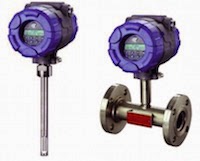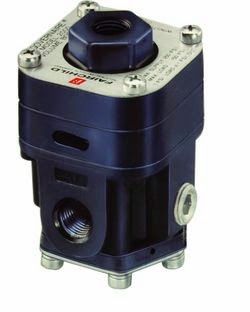 |
| Rotameter |
A rotameter, also known as a variable area flowmeter, is a device that measures the flow rate of liquid or gas in a closed tube. It measures flow rate by allowing the cross-sectional area the fluid travels through, to vary, causing a measurable effect. They are a cost-effective flow measuring device that provides excellent repeatability, requires no external power, can be made from a wide variety of materials, and may be designed for high pressure and high temperature applications.
The following are helpful, general guidelines in the proper installation of rotameters:
- Inspect meter for damage that may have occurred during shipping. Report any damage to the container to the freight carrier immediately.
- Make sure your pressure, temperature, fluid and other requirements are compatible with the meter and components (including o-rings).
- Select a suitable location for installation to prevent excess stress on the meter which may result from:
- Misaligned pipe.
- The weight of related plumbing.
- “Water Hammer” which is most likely to occur when flow is suddenly stopped as with quick closing solenoid operated valves. (If necessary, a surge chamber should be installed. This will also be useful in pressure start-up situations.)
- Thermal expansion of liquid in a stagnated or valve isolated system.
- Instantaneous pressurization which will stress the meter and could result in tube failure. note: In closed thermal transfer or cooling systems, install the meter in the cool side of the line to minimize meter expansion and contraction and possible fluid leaks at the threaded connections.
- Handle the meter carefully during installation.
- Use an appropriate amount of teflon tape on external pipe threads before making connections. Do not use paste or stick type thread sealing products.
- Over tightening of plastic connections may result in fitting damage.
- Install the meter vertically with the inlet port at the bottom.
- Meters with stainless steel fittings will support several feet of pipe as long as significant vibration or stress resulting from misaligned pipe are not factors.
- Meters with plastic fittings must be installed so that fittings are not made to support any part of the associated plumbing. In addition, meter frame should be fastened to bulkhead, panel or column.
- Meters used in gas service should have suitable valves plumbed in at the inlet and outlet of the meter. These valves should be no more than 1-1/2 pipe diameters from the meter ports. The valve at the outlet should be used to create back pressure as required to prevent float bounce. It should be set initially and then left alone. The inlet valve should be used for throttling purposes. Depending on the installation, valves may not be essential, but they are most useful in many installations. Remember: To get a correct reading of flow in gas service, it is necessary to know the pressure right at the outlet of the meter (before the valve).
- Pressure and temperature maximums must never be exceeded.







